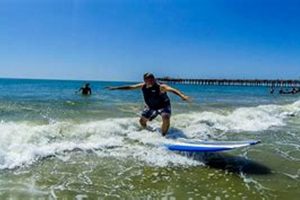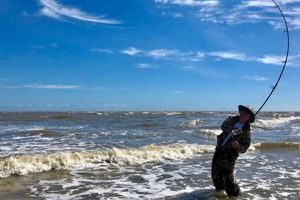The “Wedge” refers to a renowned surf break located at the easternmost end of the Balboa Peninsula in Newport Beach, California. This surf spot is characterized by its powerful waves that form when incoming swells reflect off the rock jetty, creating a unique and often dramatic wave shape. Wave reports for this area are critical for surfers and bodyboarders planning to engage in wave riding activities there; they provide information about wave height, swell direction, tide, and wind conditions.
Information concerning ocean conditions at this location holds significant importance due to the intense and potentially hazardous nature of the waves. The wave’s unique formation can lead to unpredictable breaks and powerful shore break, posing risks to even experienced water sports enthusiasts. Historical data and current reports assist individuals in making informed decisions regarding safety and preparedness before entering the water, mitigating potential injuries and ensuring a safer recreational experience. Furthermore, reliable updates on surf conditions allow experienced surfers to maximize their enjoyment of the sport, optimizing timing for favorable wave conditions.
This article will further examine the elements typically included in reports from the locale, their significance, and available resources for accessing current and historical data. Subsequently, best safety practices for the locale will be outlined to provide surfers and bodyboarders with the information needed to safely navigate this iconic and challenging wave location.
Understanding the nuances of surf conditions at this specific location is paramount for anyone considering entering the water. The following tips are designed to provide valuable insights for interpreting reports and ensuring a safer, more enjoyable experience.
Tip 1: Prioritize Wave Height Analysis: Carefully assess reported wave heights in relation to personal skill level. Wave heights can vary considerably, and even experienced surfers should exercise caution when significant increases are indicated.
Tip 2: Scrutinize Swell Direction: Understanding the swell’s angle of approach is crucial. South swells often produce the most powerful waves, while west or northwest swells may result in less intense conditions. Consider how the swell direction will interact with the jetty.
Tip 3: Evaluate Tidal Influences: Tides significantly impact the wave’s behavior. Lower tides can increase the intensity of the shore break, while higher tides may offer a slightly mellower experience. Consult tide charts in conjunction with wave reports.
Tip 4: Analyze Wind Conditions: Onshore winds can create choppy conditions and potentially dangerous closeouts. Offshore winds typically result in cleaner, more organized waves. Pay close attention to wind direction and speed in the surf report.
Tip 5: Examine Local Webcams: Supplementing surf reports with real-time visual data from local webcams is strongly recommended. This allows for direct observation of current wave conditions and helps validate report accuracy.
Tip 6: Research Historical Data: Review past surf reports and conditions to understand the typical wave patterns and swell behavior for the time of year. This can provide valuable context when interpreting current reports.
Tip 7: Observe Experienced Surfers: Before entering the water, observe experienced surfers navigating the conditions. This provides valuable insights into wave behavior, current patterns, and potential hazards.
These tips highlight the necessity of a thorough understanding of available data. Combining the information from wave reports, live webcams, and personal observations will significantly enhance safety and enjoyment.
The subsequent sections will delve into specific safety protocols and equipment recommendations to further mitigate risk and enhance the surfing experience.
1. Wave Height
Wave height, as reported in surf forecasts for the location, is a critical factor influencing both the accessibility and the potential hazards associated with surfing or bodyboarding at this renowned break. Understanding wave height and its nuances is paramount for making informed decisions about entering the water.
- Absolute Wave Height and Skill Level
The numerical wave height reported directly correlates to the power and size of the breaking waves. A novice surfer might find waves exceeding 3 feet to be challenging, while an experienced surfer may seek out waves in the 6-8 foot range, or higher. Misjudging ones abilities relative to the reported wave height can lead to dangerous situations, including wipeouts, injuries, and potential rescues.
- Wave Height Variability and Consistency
Surf reports often provide a range of wave heights, reflecting the variability within a given swell. The difference between the minimum and maximum reported wave height can indicate the consistency of the sets. A large discrepancy suggests unpredictable conditions with occasional larger waves, requiring heightened vigilance.
- Impact of Wave Height on Break Characteristics
The unique wave formation at this location means that wave height can significantly alter the way waves break. Larger wave heights often lead to more dramatic and powerful shore breaks, making the takeoff area more critical and increasing the risk of being slammed onto the sand. Smaller wave heights may still result in powerful conditions due to the wave’s unique shape. The effect of the wave height significantly impacts the wave’s character.
- Wave Height Forecasting Accuracy
While surf reports provide valuable insights, wave height predictions are not always precise. Factors such as rapidly changing weather patterns can influence the actual wave size. Therefore, relying solely on reported wave heights is insufficient. Supplementing the report with live webcam feeds and personal observation is strongly advised to confirm the accuracy of the forecast.
In summation, wave height serves as a foundational element in evaluating conditions at the location. By considering personal skill level, wave consistency, wave break characteristics and consulting supporting visual data, water sports enthusiasts can make well-informed decisions to ensure both safety and enjoyment when engaging with these iconic waves.
2. Swell Direction
Swell direction is a crucial component of any analysis for the location. The orientation from which ocean swells approach directly influences the wave quality, break characteristics, and overall surf conditions at this particular spot.
- South Swells and Wave Amplification
Swells originating from the south are optimally aligned with the orientation of the rock jetty. This alignment allows for maximum wave reflection and subsequent wave amplification, resulting in the formation of the characteristic waves. Consequently, reports indicating a significant south swell typically correlate with the largest and most powerful waves observed. The angle of the swell approaching directly faces the jetty creating huge waves
- West and Southwest Swells
Swells from the west or southwest still generate wave activity. However, the waves are generally smaller and less consistent compared to those produced by south swells. These swell directions may result in a less defined wave peak and a reduced likelihood of the extreme wave formations that define the spot.
- Northwest Swells and Wave Refraction
Northwest swells tend to refract, or bend, around the Balboa Peninsula before reaching the wave location. This refraction can reduce wave energy and alter the wave’s shape. Waves resulting from northwest swells are typically smaller and less predictable. These wave situations may cause more dangerous surf conditions
- Swell Period and Wave Energy
Swell period, the time between successive wave crests, is directly related to wave energy. Longer swell periods translate to more powerful waves. Reports indicating a long-period swell originating from the south suggest the potential for particularly large and forceful waves.
In summary, swell direction is a primary determinant of surf conditions at this unique spot. South swells coupled with long swell periods represent the optimal combination for powerful waves, while westerly or northwesterly swells typically result in smaller and less predictable conditions. The swell direction significantly alters the break’s typical wave condition.
3. Tidal Stage
Tidal stage exerts a significant influence on wave characteristics at the Newport Beach surf break known as “The Wedge.” The cyclical rise and fall of sea level alter wave formation, break patterns, and the overall safety profile of this unique surfing location, necessitating careful consideration of tidal information within the broader surf report.
- Low Tide and Shore Break Intensity
At low tide, the ocean depth decreases, causing waves to break more abruptly and closer to shore. This phenomenon intensifies the shore break, increasing the potential for powerful closeouts and hazardous impacts with the sand. The shallow water depth offers reduced forgiveness and amplifies the risk of injuries.
- High Tide and Wave Moderation
High tide conditions generally increase water depth, resulting in a less abrupt wave break and a slightly more forgiving environment. The increased water volume allows waves to maintain their form for a longer duration, potentially reducing the intensity of the shore break and creating a more manageable experience for experienced surfers.
- Incoming vs. Outgoing Tides
Incoming, or flood, tides can be associated with increased wave size and energy as the rising water level interacts with incoming swells. Conversely, outgoing, or ebb, tides may lead to a decrease in wave size and power as the water recedes. Awareness of whether the tide is rising or falling provides additional context for interpreting wave conditions.
- Tidal Range and Extreme Conditions
The tidal range, or the difference between high and low tide levels, can significantly impact wave behavior. A large tidal range can create dramatic shifts in wave intensity throughout the day, with extreme low tides exposing submerged hazards and extreme high tides potentially creating backwash effects against the jetty.
Considering the tidal stage alongside other factors such as swell direction and wave height is crucial for accurately assessing the surf conditions at the location. A comprehensive understanding of tidal influences allows surfers and bodyboarders to make informed decisions, mitigating risks and maximizing their enjoyment of this iconic surf break.
4. Wind Conditions
Wind conditions are a critical parameter within any report concerning the location, exerting a considerable influence on wave quality, surface texture, and overall surfing experience. The interaction between wind and wave is complex, often determining whether conditions are favorable, marginal, or entirely unsuitable for wave riding activities. Understanding this interplay is crucial for anyone consulting surf reports for this area.
Onshore winds, blowing from the ocean towards the shore, typically degrade wave quality. They create chop and disrupt the clean lines of the waves, making takeoffs more challenging and increasing the likelihood of closeouts. Strong onshore winds at this location can render the surf unrideable due to the resulting chaotic wave faces. Offshore winds, blowing from the land towards the ocean, generally improve wave quality. These winds groom the wave face, creating a smooth, glassy surface ideal for surfing. Light offshore winds can hold up the wave, delaying its break and providing surfers with more time to position themselves for a successful ride. Strong offshore winds, however, can also present challenges by causing waves to break too quickly or by making paddling against the wind difficult.
Cross-shore winds, blowing parallel to the shoreline, can have variable effects depending on their strength and angle. Light cross-shore winds might have a minimal impact, while stronger cross-shore winds can create uneven wave shapes and potentially dangerous currents. Given the location’s unique wave formation, wind direction needs careful consideration. Analyzing wind direction and its projected effect on wave conditions significantly aids in decision-making regarding safety and enjoyment. Understanding wind conditions, as reported, is paramount to interpreting overall surf suitability and predicting potential hazards at the spot.
5. Local Webcams
Local webcams serve as a vital supplementary resource to traditional reports concerning conditions at this specific location. These webcams provide real-time visual confirmation of reported wave height, swell direction, and wind conditions, enhancing the accuracy and reliability of surf assessments.
- Real-Time Verification of Surf Conditions
Webcams offer an immediate, visual assessment of wave size, shape, and breaking patterns. This real-time information helps validate or invalidate the numerical predictions found in surf reports, which can be subject to inaccuracies due to rapidly changing weather patterns or localized effects.
- Assessment of Crowds and Water Activity
Beyond wave characteristics, webcams provide insight into the number of surfers and bodyboarders present at the location. This information is crucial for assessing potential congestion and competition for waves, contributing to a more informed decision about whether to enter the water.
- Identification of Hazards and Changing Conditions
Webcams can reveal localized hazards such as strong currents, debris in the water, or sudden changes in wave conditions that may not be explicitly mentioned in written reports. This visual information allows surfers to identify potential risks before entering the water.
- Evaluation of Wind Effects and Surface Texture
Webcams effectively display the impact of wind on wave surface texture. By observing the water’s surface, users can assess the presence of chop or the degree to which offshore winds are grooming the waves, further refining their understanding of the surf conditions.
Local webcams provide a critical layer of validation and detail that enhances the utility of surf reports. The visual confirmation of wave conditions, coupled with insights into crowds, hazards, and wind effects, empowers surfers and bodyboarders to make more informed decisions, ultimately contributing to a safer and more enjoyable experience at this renowned location.
Frequently Asked Questions
The following section addresses common inquiries regarding surf conditions at the specified locale, specifically focusing on factors influencing wave assessment and safety.
Question 1: What constitutes a “good” surf report for this location?
An optimal report generally indicates a south swell with a period exceeding 10 seconds, wave heights in the 4-6 foot range, light offshore winds, and a mid-tide. However, interpretation varies with individual skill level.
Question 2: How frequently are surf reports updated?
Most reputable surf forecasting websites update their reports multiple times daily, typically every 6 to 12 hours. Real-time webcam observations provide even more immediate condition assessments.
Question 3: What inherent limitations exist within these surf reports?
Surf reports provide predictive models, not guarantees. Localized wind patterns, sudden swell changes, and the dynamic nature of the ocean environment can cause conditions to deviate from forecasts.
Question 4: What role do experienced local surfers play in condition assessment?
Experienced local surfers possess invaluable insights into the microclimates and nuances of the break. Observing their behavior and heeding their advice provides critical supplemental information.
Question 5: How do tides impact the wave formation, and what is the ideal tidal range?
Low tides intensify the shore break, while high tides moderate it. The optimal tidal range depends on individual preferences and skill, but mid-tides often provide the most balanced conditions.
Question 6: What equipment is essential for surfing/bodyboarding at this particular location?
Proper equipment includes a well-maintained surfboard or bodyboard, appropriate fins, a properly fitted leash, and potentially a helmet or impact vest for added protection, especially in larger conditions.
Accurate surf assessments require a multifaceted approach, combining numerical forecasts, visual observations, and the wisdom of experienced locals. Safety should remain the paramount concern.
The following section will address the safety protocols required at this wave location.
Newport Beach Surf Report Wedge
The preceding analysis elucidates the multifaceted nature of the “newport beach surf report wedge.” Accurate interpretation requires a synthesis of wave height, swell direction, tidal stage, and wind conditions, supplemented by real-time visual data. Each parameter contributes uniquely to wave formation, break characteristics, and the overall safety profile. Neglecting any component can result in misjudgments with potentially severe consequences.
Continued vigilance and informed decision-making are paramount for those engaging with this dynamic coastal environment. The “newport beach surf report wedge” serves as an essential tool, but its utility hinges on the user’s understanding of its limitations and the integration of supplemental information. Prioritizing safety, respecting the ocean’s power, and seeking guidance from experienced locals will contribute to a safer and more rewarding experience at this iconic surf location.







